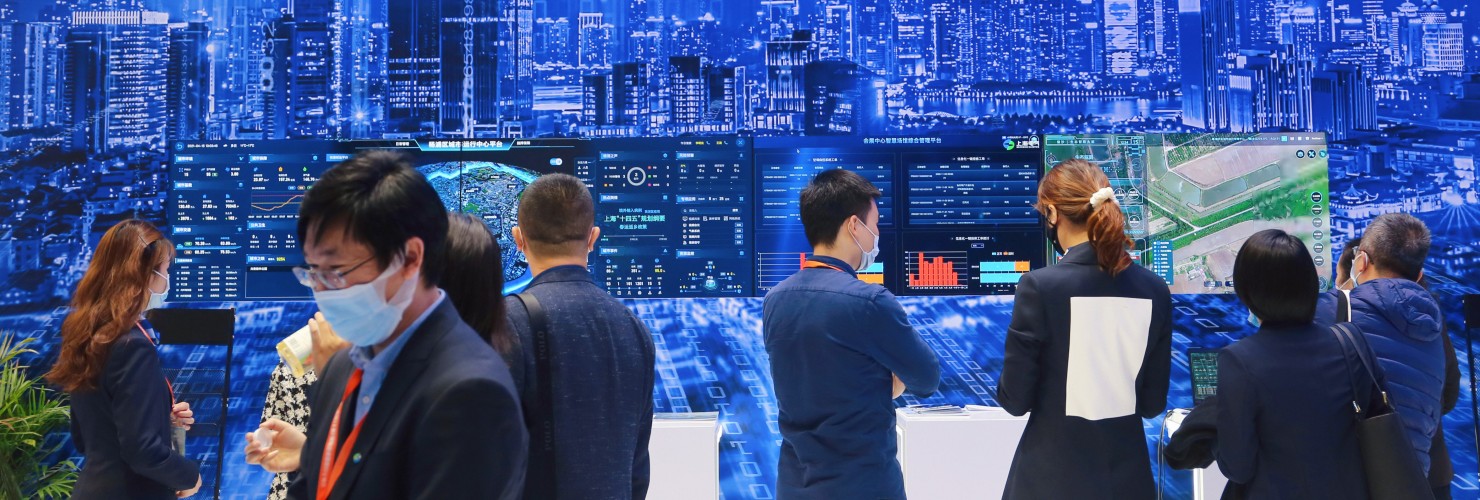

Intellectual property rights + Energy consumption + Transport sector
1. China ramps up IP protection to defend interests of Chinese firms
At a glance: The Central Committee of the Communist Party of China and the State Council issued guidelines to build a powerful intellectual property rights (IPR) country. The plan outlines policies and laws to be fleshed out by government ministries and numerical goals for 2025. Specific targets include:
- Construct a strong IPR country by 2025 in which the added value of patent-intensive industries accounts for 13 percent of GDP, and annual trade in IP royalties totals CNY 350 billion
- Achieve 12 high-value invention patents per 10,000 people by 2025 and cultivate enterprises that produce IP rights such as patents and trademarks
- Improve the IP legal system, particularly in new fields such as big data, AI and genetic technology and increase damages for IP infringements
- Participate in the construction and reform of global IPR governance e.g., by promoting IP bi- and multilateral negotiations and information sharing
MERICS comment: The plan is an extension of China’s policy ambitions, going back to the “Made in China 2025” strategy from 2015, that aims to transform Chinese companies from low- and mid-range assemblers to owners and creators of intangible assets like intellectual property in the global economy. While China has indeed been taking steps to improve its IP legal system, this has only partly been due to pressure of foreign business associations and governments. China’s main motivation has been self-interest. Previously, it was in China’s interest to have weak IPR to facilitate technology transfers. Now, efforts to improve China’s IP system, such as the amendments to China’s Patent Law effective since June 1, 2021, demonstrate their increased technological capabilities and an ambition to strengthen innovation as a key driver of China’s economic growth. In certain sectors, like telecommunications and AI, Chinese firms already produce high-quality IP.
The consequences for multinational companies (MNCs) are twofold. Firstly, IP protection in China will see further strengthening, e.g., through increased damages for IP infringement. The European Chamber of Commerce in China attests to a steady improvement in China’s IPR enforcement. This could embolden MNCs to further transfer high-tech production and R&D to China. Yet significant inadequacies remain in IPR enforcement as China applies the law on its own terms, and thereby keeps law a tool of Chinese policy. The policy did not mention any plans to increase the transparency of the judicial system. Secondly, with more indigenous Chinese IPR and a legislative system geared to favor Chinese firms, more Chinese companies will go after foreign ones. Chinese firms are increasingly taking the offensive and suing foreign competitors for infringing on their IPR. What’s more, Chinese courts have started granting anti-suit injunctions with the aim to block foreign companies from taking legal action abroad.
Policy name: Guidelines for Building a Powerful Intellectual Property Rights Country (2021-2035) (中共中央 国务院印发《知识产权强国建设纲要(2021-2035年)》) (Link)
Issuing bodies: CCPCC, State Council
Date: September 22, 2021
2. Curb on energy consumption to impact commodity prices
At a glance: The National Development and Reform Commission (NDRC) released a notice on improving measures to curb energy intensity and total energy consumption as part of the “dual control system.” The plan aims to improve the allocation and efficient use of resources and optimize the energy structure over the course of the next 15 years, in line with China’s commitment to peak emissions by 2030. Key measures outlined in the plan include:
- Establish two targets, one binding and one as an incentive, for provinces to reduce energy intensity and total consumption, based on local conditions e.g., level of economic and social development, industrial structure and layout, etc.
- Rigorously control energy and emissions intensive projects, with the NDRC and other relevant departments to guide new projects with an energy consumption of 50,000 tons of coal equivalent or more
- Facilitate the trading of energy use rights, so that provinces which advance quickly and surpass their energy consumption targets can sell their surplus to provinces which do not meet their targets
MERICS comment: Last month the NDRC announced that in the first half of 2021, 19 of China’s provincial level governments failed to meet their energy consumption reduction targets, with nine provinces registering a rise instead of a fall year-on-year. Even if the economic rebound is partly to explain for this occurrence, China’s policymakers are now applying more pressure to push regional governments to meet their targets. Local officials will be held responsible for the developments in their province.
Stricter enforcement of the energy consumption targets will likely result in an end to artificially suppressed energy prices, which effectively subsidize production in energy intensive industries. Widespread power outages that spread across China in August and September – primarily caused by record high coal prices which make it unprofitable for many power plants to operate – put immediate pressure on the government to adjust power price regulations. Additional costs for energy intensive industries will lead to a decline in output.
This means global prices are likely to remain high for commodities where China dominates global production and is starting to wind down capacity, such as steel. Adding to a reduction in supply and disrupted supply chains, prices will rise further due to increased demand in some cases, e.g., aluminum is growing in importance as an input for electric vehicles and renewable energy products.
Policy name: Notice on issuing the “Improving the Double Control System Program for Energy Consumption Intensity and Total Amount” (国家发展改革委关于印发《完善能源消费强度和总量双控制度方案》的通知) (Link)
Issuing body: NDRC
Date: September 16, 2021
3. MOST partners with China Development Bank to boost application of R&D
At a glance: The Ministry of Science and Technology (MOST) and the China Development Bank released a notice stating that they will work together on issuing over CNY 10 billion in special purpose bonds to increase financing for the transformation of science and technology (S&T) achievements. This refers to the transfer of innovative technological achievements from scientific research units to the production sector, resulting in new products, improved processes, increased efficiency, etc. The key goals for the joint initiative are to:
- Support demonstration projects on the transformation of S&T achievements and successfully bring several breakthrough technologies to market
- Build regional innovation hubs, advance the growth of 100 national innovation cities and 100 national high-tech parks i.e., “100 Cities and 100 Parks” initiative
- Develop national technology innovation centers and key laboratories and direct universities and research institutes to align research activities with the needs of enterprises
- Facilitate the incubation of innovative small- and medium-sized enterprises (SMEs) with leading innovative enterprises supporting the growth of science focused SMEs
MERICS comment: The notice reflects a weakness in China’s innovation system, whereby 76.6 percent of R&D is carried out by the private sector, yet the application of S&T innovation remains limited. The transformation rate of S&T achievements for China is cited at just 30 percent compared to about 60 or 70 percent in advanced economies. To bridge this gap, policymakers are supporting SMEs to move beyond the R&D stage into production. For example, in addition to special purpose bonds, the government’s “little giant” program offers targeted supported to SMEs to enhance China’s technological capabilities and create more secure supply chains (see July issue).
Yet more can be done, and China’s leadership is eager to channel both private and public funds towards small innovative firms. As it stands, China’s financial system does not funnel sufficient money towards these companies, with few people willing to invest in such risky ventures. As such, President Xi announced the launch of the Beijing Stock Exchange (BSE) dedicated to supporting innovative SMEs, to improve the accessibility and efficiency of capital allocation to promising firms.
While each of these measures may not be significant on their own, taken together they could help to foster new tech leaders in sectors where China has an advantage, for example, in data-rich industries like AI. Foreign firms operating in such sectors will need to watch out for emerging competitors. The push for Chinese public research institutes to collaborate closely with domestic tech companies will put foreign firms at a further disadvantage.
Policy name: Notice on Special Purpose Bonds for the Industrialization of Major Scientific and Technological Achievements (科技部办公厅 国家开发银行办公室关于开展重大科技成果产业化专题债有关工作的通知) (Link)
Issuing bodies: MOST, China Development Bank
Date: September 18, 2021
4. China promotes basic research to emerge as “transport superpower”
At a glance: The Ministry of Transportation (MOT) and MOST issued guidelines that aim to promote S&T innovation in the transport sector by supporting more basic research. The government aspires to make innovation the driving force behind the development of the transport sector, thus relying relatively less on capital-and labor-intensive inputs. Targets include:
- Achieve breakthroughs in core transport technologies by 2025 and fully “autonomous and controllable” core technologies by 2035
- Strengthen basic and applied research in the transport sectors, for example on human-computer interaction, the processing of new materials and life cycle performance
- Integrate new generation IT such as AI and cloud computing and apply new manufacturing methods such as additive manufacturing and the use of new materials in transportation
- Establish S&T innovation bases, innovation alliances, industrial parks and cooperation projects to promote innovation in the transport field
MERICS comment: By 2050, China wants to emerge as a “transport superpower” with leading global transport companies. China has so far relied on technology transfers, restrictive market access and heavy public investment to upgrade its transport sector. In modifying this strategy, MOT and MOST emphasize the need for Chinese companies to conduct more basic research. In support, MOT has recently approved 15 transport superpower pilot research projects initiated by SOEs, provinces and universities.
The policy’s emphasis on “autonomous and controllable” technology signals that Chinese decisionmakers are increasingly worried that Washington could derail its current upgrading strategy through export controls. Particularly in the aviation sector, China remains heavily dependent on foreign technology inputs. Sanctions or export controls could be a severe setback for China’s superpower ambitions. For example, research on China’s prestige project, the COMAC C919 jet, shows that only 14 out of 82 key suppliers are from China (including Sino-foreign JVs) and China relies on foreign suppliers’ know-how to integrate the different components.
For foreign companies the policy is largely bad news. While foreign companies could profit from increasing demand for high-tech components, foreign competition and Chinese government preference for domestic production means that onshoring pressure will likely continue. In the long-term the policy shows an ambition to foster homegrown suppliers that are “autonomous and controllable,” which could replace even onshore foreign suppliers. This is facilitated by opaque and unfair procurement processes and the dual-use nature of products or services in the shipbuilding and aerospace sectors.
Policy name: Opinions on Science and Technology Innovation to Accelerate the Development of China into a Transport Superpower (交通运输部 科学技术部关于科技创新驱动加快建设交通强国的意见) (Link)
Issuing bodies: MOT, MOST
Date: August 26, 2021
5. MOFCOM turns to cutting red tape and imports to boost consumption
At a glance: The Ministry of Commerce (MOFCOM) released a notice instructing local officials to take measures to boost consumption. The document points out that China’s economic recovery has been on shaky ground in recent months and that consumption has been impeded by the pandemic situation from late July onwards. Products and sectors given particular attention include new and secondhand vehicles, home appliances, furniture and home furnishings, as well as the food and beverage industry. To achieve a rebound in consumption, MOFCOM advises local officials to:
- Support traditional enterprises to accelerate digitalization, smart transformation and cross-border integration
- Cultivate environmentally friendly consumption habits, provide subsidies to phase out inefficient vehicles and home appliances and replace them with new green products
- Expand the consumption of imports, support large trade and distribution enterprises and e-commerce platforms to set up special channels for the sale of imported products
MERICS comment: The notice mirrors another policy released earlier in January 2021 by MOFCOM and 11 other government authorities that outlined measures to boost consumption in the same industries. Despite repeated claims that China is moving towards a consumption-based economy, the government has struggled to increase consumption growth. In some cases, strict regulation in the purchasing of consumer goods acts as a hindrance, for example the latest notice lists relaxing restrictions on the purchasing of new cars and on the relocation of used vehicles to other provinces among its aims. A notice issued in late August by six government agencies on increasing parking facilities in urban areas will also serve to spur consumption. While foreign branded carmakers – which account for about 55 percent of car sales in China – stand to benefit from such measures, their effect is likely to be limited and delayed. Parking infrastructure will take months, if not years, to develop and local officials are wary of avoiding excessive traffic congestion and pollution.
Policymakers hope to further leverage trade in the pursuit of broader economic aims, with calls in the new policy to increase support for used car export businesses. Imports and exports generate income and employment for firms in the e-commerce, trade and distribution sectors, as well as strengthen economic interdependencies between China and its trading partners. Foreign firms should closely monitor special channels on e-commerce platforms that promote imports to strengthen their position within the Chinese market.
Policy name: Notice on Further Improving the Current Key Work of Promoting Consumption in the Commercial Sector (商务部关于进一步做好当前商务领域促消费重点工作的通知) (Link)
Issuing body: MOFCOM
Date: September 16, 2021
WORTH NOTING
Policy news
- September 3: The State Council releases measures to promote trade and investment in pilot free trade zones and wants to facilitate the import of products such as pharmaceuticals (State Council notice (CN))
- September 6: The Ministry of Industry and Information Technology (MIIT) discloses the amount of electric vehicle subsidies (purchasing subsidies) received by carmakers from 2016 to 2020 (MIIT announcement (CN))
- September 10: Shanghai releases an action plan to develop its industrial software industry; the city wants to promote at least 10 stock exchange listed firms by 2023 and will encourage companies to use software included in a new catalogue (Shanghai municipal government notice (CN))
- September 13: At a press conference held by the State Council Information Office, MIIT minister Xiao Yaqing says that China has too many NEV companies and that the industry should become stronger and less fragmented (State Council Information Office announcement (CN))
- September 15: The NDRC and Ministry of Ecology and Environment release a five-year plan to control plastic pollution; plastic waste is to be substantially reduced and alternatives for plastics developed (NDRC announcement (CN))
- September 16: NDRC starts soliciting opinions on the revision of the “Market Access Negative List” (NDRC notice (CN))
- September 25: Several government agencies including the NDRC ban the mining of virtual currencies, listing this as an “outdated industry” (State Council notice (CN))
Corporate news
- September 1: South Korean battery maker SK Innovation announces that it will invest USD 1 billion in a new battery plant in China (Reuters article (EN))
- September 3: China’s Semiconductor Manufacturing International (SMIC) plans to build a USD 8.9 billion chip plant in Shanghai (Sohu article (CN); Reuters article (EN))
- September 9: Swedish telecommunications firm Ericsson says it will shut down one of its five research centers in China; according to plans the 630 employees will be transferred to Finnish software company TietoEVRY (SCMP article (EN))
- September 13: The Beijing branch of the China Automotive Engineering Research Institute (CAERI) reveals that it has tested machines to track whether car data is sent abroad (CAERI press release (CN))
- September 13: Chinese regulators break up Alipay, by forcing Ant to create an independent loans app whereby user data will be handed over to a new state-owned credit scoring JV (FT article (EN))
- September 14: South Korea’s Samsung Heavy Industries is in talks with the Chinese government to hand over assets owned by its Ningbo-based plant; the decision to close the plant has caused workers to protest (Ship Technology article (EN); Nikkei article (EN))
- September 16: German BASF and China’s CATL sign a strategic partnership on battery material solutions, with the aim to develop a sustainable battery value chain (BASF press release (EN))
- September 23: Volkswagen announces that it will build a new EV battery system factory in Hefei, production is supposed to start in 2023 (Reuters article (EN); Volkswagen press release (GER))
- September 28: China International Marine Containers says it will acquire Maersk Container Industry for USD 1.08 billion to ramp up its cold storage container output (Yicai article (EN))
- September 28: Chinese battery producer Contemporary Amperex Technology (CATL) agrees to buy Canadian miner Millenial Lithium Corp for USD 297.3 million (Reuters article (EN))

